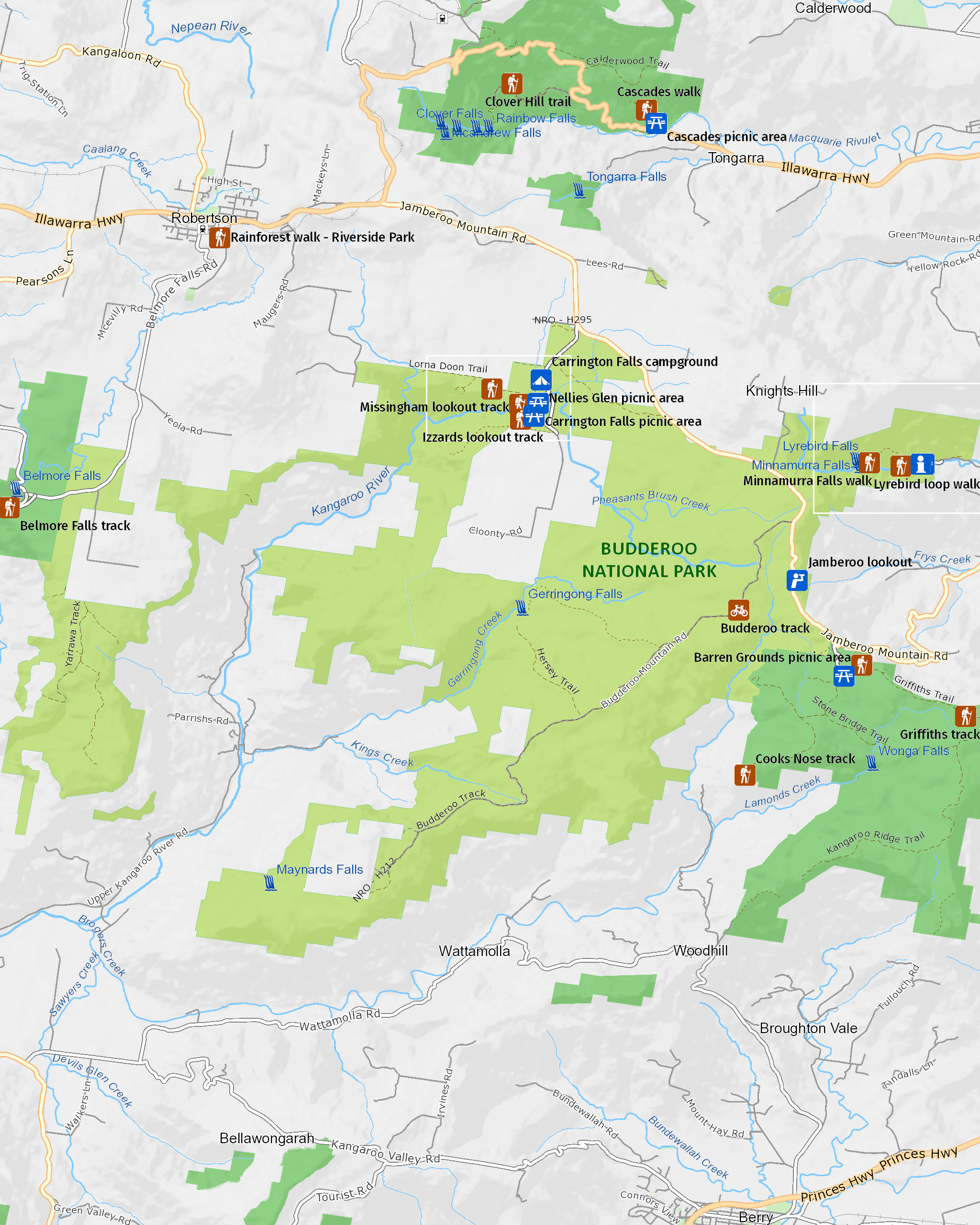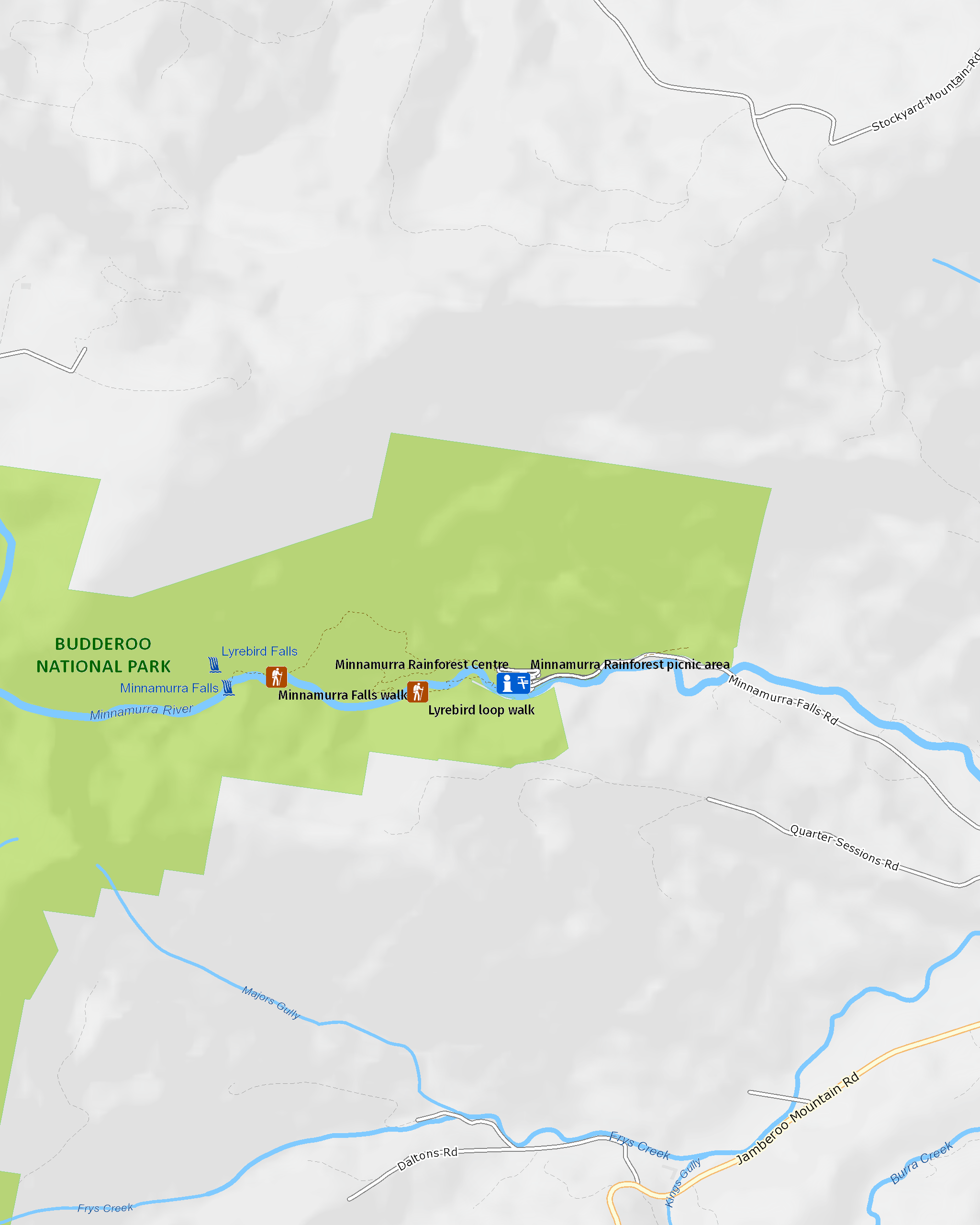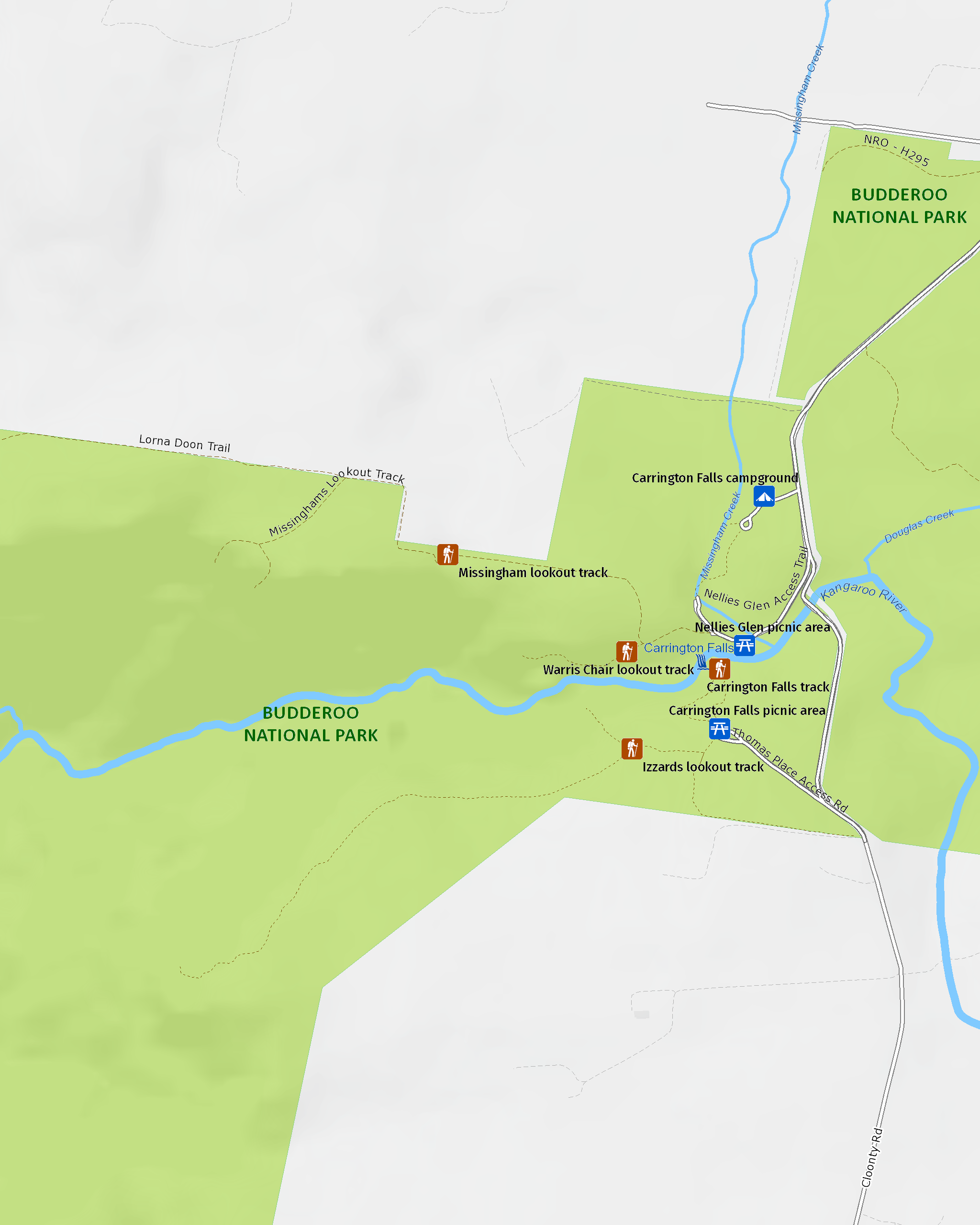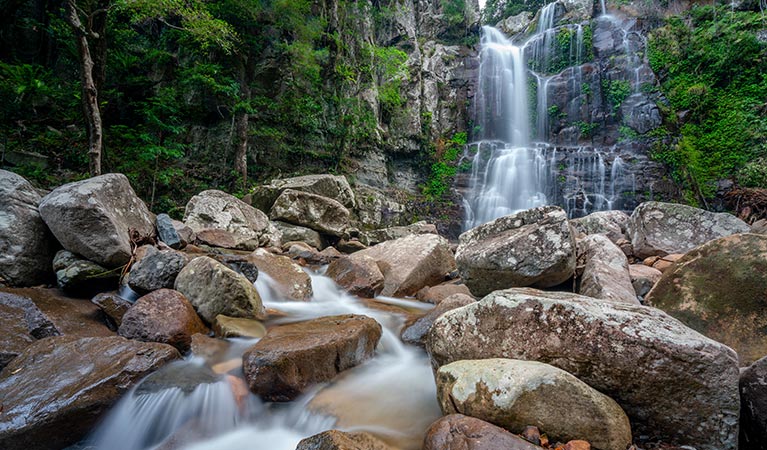Budderoo National Park
Overview
Budderoo National Park, on the south coast of NSW, is known for its gorgeous waterfalls and lookouts. Enjoy rainforest walks and birdwatching opportunities on a school excursion or day trip.
Read more about Budderoo National Park
Nature-lovers will be in their element at beautiful Budderoo National Park. From pristine rainforest walks to gorgeous waterfalls and stunning lookouts, it’s easy to create a memorable itinerary through this enchanting haven.
Stop by the multi award-winning Minnamurra Visitor Centre, then take to its elevated walkways and paved tracks and lose yourself in the lush beauty of the rainforest. See if you can spot a shy lyrebird in the undergrowth while you’re there. Afterwards, relax over lunch at the picnic area.
Drive up to the plateau above Minnamurra Rainforest and discover jaw-dropping views from Jamberoo lookout or bring your mountain bike and ride the 24km Budderoo Track – you’ll see wildflowers blooming in late winter and spring.
Local alerts
For the latest updates on fires, closures and other alerts in this area, see https://www.nationalparks.nsw.gov.au/visit-a-park/parks/budderoo-national-park/local-alerts
Map

Map

Map

Map legend

Contact
- in the South Coast and Country NSW regions
Budderoo National Park is always open but may have to close at times due to poor weather or fire danger. The park gates at Minnamurra Rainforest Centre open at 9am and close at 5pm every day.
-
Park entry fees:
$12 per vehicle per day only in the Minnamurra Rainforest area. Bus or taxi: $4.40 per adult and $2.20 per child.
Buy annual pass. -
-
Minnamurra Rainforest Centre
02 4236 0469
Contact hours: 9am to 4pm daily. Closed Christmas Day. - 345 Minnamurra Falls Road, Jamberoo NSW 2533
-
Email: Minnamurra@environment.nsw.gov.au
-
Minnamurra Rainforest Centre
Visitor info
All the practical information you need to know about Budderoo National Park.
Maps and downloads
Visitor centre
-
Minnamurra Rainforest Centre
345 Minnamurra Falls Road, Jamberoo NSW 2533 - 9am to 4pm daily. Closed Christmas Day.
- 02 4236 0469
Nearby towns
Jamberoo (6 km)
If the kids are on board, take them to Jamberoo Action Park, where Billabong Beach, Rapid River and Outback Bay will keep them entertained for a whole day. Minnamurra Rainforest is also close by, with easy walks through the rainforest for the whole family to enjoy.
Robertson (8 km)
Robertson is known as the 'green heart of the Highlands' for a good reason - it's always green. Rich, fertile soil and abundant rural farmland make up Robertson's scenic landscape. It serves as a gateway to some of the State's best waterfalls.
Nowra (56 km)
Nowra is a historic city and the commercial heart of the Shoalhaven. It's on the Shoalhaven River close to beaches and national parks.
Learn more
Budderoo National Park is a special place. Here are just some of the reasons why:
A splash of relaxation

Nurtured and conserved for over a century, the Minnamurra Rainforest is exceptionally precious. At this much-loved tourism destination, you can wander raised boardwalks and explore the rainforest that once blanketed much of the region. For the ultimate experience, combine the Lyrebird loop walk and Minnamurra Falls walk and discover exquisite plants and animals in breathtaking surroundings. If you’ve ever fallen asleep to the sounds of a relaxation CD, you’ll know the peaceful power of waterfalls. And with its own wonderful falls, Budderoo might just be one of the most relaxing places around. Walk to Minnamurra Falls, an amazing double-tiered waterfall, or Carrington Falls, with its fabulous 50m drop. Sit back, listen to the hypnotic sound of flowing water and let your cares drift away.
- Carrington Falls picnic area Be wowed by Carrington Falls from one of three lookouts with great views. You’ll find picnic and barbecue facilities close by along with some short walking tracks.
- Carrington Falls walking track Discover fantastic waterfall views on the short Carrington Falls walking track, in Budderoo National Park, near Robertson. It’s a great day trip for families and nature lovers in the Southern Highlands.
- Friends of Minnamurra Rainforest You don’t have to be a weeding specialist to get involved in volunteer work at Minnamurra Rainforest. Join local experts and like-minded volunteers for bush regeneration in Budderoo National Park.
- Jamberoo lookout Enjoy spectacular scenic views of Kiama and Lake Illawarra from Budderoo National Park’s Jamberoo lookout. On clear days, this lookout is fantastic for photography.
- Minnamurra Rainforest Centre Visit Minnamurra Rainforest Centre in Budderoo National Park and chat to the friendly staff before exploring the rainforest along raised boardwalks.
Walk through history

A walk around the park reveals its many uses over the years. Spot remaining cedar trees, so prized by foresters in the 1800s. Head downstream from the Minnamurra Rainforest to see the 1853 Kelly's Cottage and its camellia tree, believed to be one of the southern hemisphere's oldest. The land's rich soil and water supply make it ideal for dairy farming, and you can still see the monument to Australia's first butter factory in nearby Jamberoo Valley.
Park life

You're almost guaranteed to see wildlife in the park, particularly if you visit Minnamurra Rainforest Centre. Look for bowerbirds and king parrots, and visit between June and August for the spectacular image of a male lyrebird displaying his tail. You've a good chance of spotting a swamp wallaby at dawn or dusk, and keep an eye out for an eastern water dragon or perhaps even a diamond python soaking up the sunshine.
- Birds of Minnamurra self-guided audio tour Take a self-guided audio tour along Lyrebird loop walk with fauna ecologist David Bain and discover some of the fascinating birds that live in Minnamurra Rainforest. See if you can spot the ones that David points out as you explore the incredible subtropical rainforest of Budderoo National Park.
- Investigating the living world: Minnamurra Join us as we explore living things on this Stage 3 (Years 5 to 6) Science and technology excursion. Students will investigate and analyse the natural environment of Minnamurra Rainforest, Budderoo National Park.
- Junior ranger: Minnamurra Rainforest Become a ‘junior ranger’ these school holidays at Minnamurra Rainforest. You’ll learn hands-on bush survival and safety skills on this fun tour at Budderoo National Park.
- Life in the rainforest: Minnamurra Rainforest Join us as we explore life in the rainforest on this Stage 2 (Years 3-4) Science and Technology excursion at Minnamurra Rainforest. Students will carry out investigations to explore the living world in this beautiful part of Budderoo National Park.
- Living world: Minnamurra Rainforest Explore the Living World with us on this Stage 1 (Years 1-2) Science and Technology at Minnamurra Rainforest in the Budderoo National Park. Students will explore the rainforest environments and learn the importance of plant and animal habitat.
Plants and animals protected in this park
Animals
-

Spotted-tailed quoll (Dasyurus maculatus)
The spotted-tailed quoll is the largest remaining carnivorous marsupial on the Australian mainland. It’s protected as a vulnerable species in NSW.
-

Eastern ground parrot (Pezoporus wallicus wallicus)
The eastern ground parrot is a beautiful, ground-dwelling native bird that lives in low heathland habitat along the NSW North and South coasts and escarpments. It’s listed as a vulnerable species in NSW.
-

Platypus (Ornithorhynchus anatinus)
One of the most fascinating and unusual Australian animals, the duck-billed platypus, along with the echidna, are the only known monotremes, or egg-laying mammals, in existence. The platypus is generally found in permanent river systems and lakes in southern and eastern NSW and east and west of the Great Dividing Range.
-

Superb fairy wren (Malurus cyaneus)
The striking blue and black plumage of the adult male superb fairy wren makes for colourful bird watching across south-eastern Australia. The sociable superb fairy wrens, or blue wrens, are Australian birds living in groups consisting of a dominant male, mouse-brown female ‘jenny wrens’ and several tawny-brown juveniles.
Plants
-

Cabbage palm (Livistona australis)
With glossy green leaves spanning 3-4m in length and a trunk reaching a height of up to 30m, the cabbage tree palm, or fan palm, is one of the tallest Australian native plants. Thriving in rainforest margins along the east coast of NSW, in summer this giant palm produces striking spikes of cream flowers which resemble cabbages.
-

Old man banksia (Banksia serrata)
Hardy Australian native plants, old man banksias can be found along the coast, and in the dry sclerophyll forests and sandstone mountain ranges of NSW. With roughened bark and gnarled limbs, they produce a distinctive cylindrical yellow-green banksia flower which blossoms from summer to early autumn.
-

Coachwood (Ceratopetalum apetalum)
Coachwood trees are Australian native plants that grow in warm temperate rainforests along coastal NSW. Also known as scented satinwood, the mottled grey bark of the coachwood has horizontal markings and a delicate fragrance.
Environments in this park
Education resources (1)
School excursions (14)
- Earth's natural systems at Minnamurra Rainforest, Stage 6 (Years 11-12), Geography
- Factors that shape places at Minnamurra Rainforest, Stage 3 (Years 5-6), Geography
- Landscapes and landforms at Minnamurra Rainforest, Stage 4 (Years 7-8), Geography
- A dynamic ecosystem: Minnamurra Rainforest, Stage 6 (Years 11-12), Biology
- Environmental change and management at Minnamurra, Stage 5 (Years 9-10), Geography
- Exploring the rainforest: Minnamurra Rainforest Centre, Stage 1 (Years 1-2), Geography
- Rainforest ecosystems - Minnamurra , Stage 5 (Years 9-10), Science
- The Minnamurra Rainforest ecosystem, Stage 6 (Years 11-12), Geography
- Protecting a rainforest environment: Minnamurra, Stage 2 (Years 3-4), Geography
- Investigating the living world: Minnamurra, Stage 3 (Years 5-6), Science and Technology
- Life in the rainforest: Minnamurra Rainforest, Stage 2 (Years 3-4), Science and Technology
- Living world: Minnamurra Rainforest, Stage 1 (Years 1-2), Science and Technology
- Survival in the rainforest: Minnamurra, Stage 4 (Years 7-8), Science
- Sustainable biomes at Minnamurra Rainforest, Stage 5 (Years 9-10), Geography
What we're doing
Budderoo National Park has management strategies in place to protect and conserve the values of this park. View the detailed park and fire management documents. Here is just some of the work we’re doing to conserve these values:
Preserving biodiversity
Budderoo National Park is resolute in its commitment to conserving land, minimising weeds and protecting native vegetation. The park supports ongoing NPWS and volunteer efforts to maintain biodiversity.
Managing weeds, pest animals and other threats
Pests and weeds have a significant impact to the ecosystems within Budderoo National Park. Risk assessments for new and emerging weeds are carried out as an ongoing initiative within the park. Pest management is an important part of the work NPWS does to protect the integrity of biodiversity which exists within Budderoo.
Developing visitor facilities and experiences
Budderoo National Park undertakes regular maintenance of its facilities to ensure they are up to date and safe for visitors to use. Hazard assessments and facilities upgrades are regularly carried out in this park, and priority actions are implemented both in the park itself and in Minnamurra Rainforest Centre.
Managing fire
NSW is one of the most bushfire prone areas in the world as a result of our climate, weather systems, vegetation and the rugged terrain. NPWS is committed to maintaining natural and cultural heritage values and minimising the likelihood and impact of bushfires via a strategic program of fire research, fire planning, hazard reduction, highly trained rapid response firefighting crews and community alerts.

